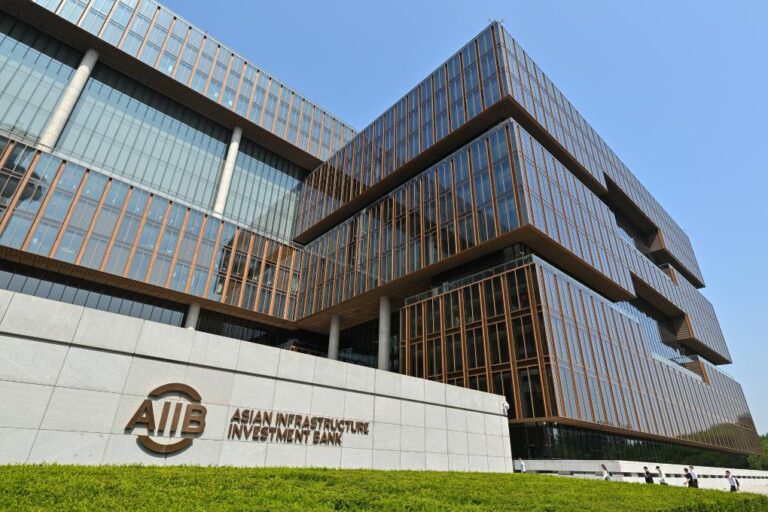* Founded in 2015, AIIB has grown from 57 founding members to 110 across six continents, covering 81 percent of the world’s population and 65 percent of global GDP.
* “AIIB was established on the principles of multilateralism and high international standards,” the bank’s president Jin Liqun said, noting that these principles have enabled the bank to earn broad trust and participation across the globe.
* Amid rising global challenges, AIIB is positioning itself as a future-oriented development bank that supports both traditional and digital infrastructure for the long haul.
BEIJING, June 24 (Xinhua) — As the Asian Infrastructure Investment Bank (AIIB) marks its 10th anniversary, the multilateral development bank is playing an increasingly prominent role in advancing connectivity, green growth, and sustainable development across regions.
Founded in 2015, AIIB has grown from 57 founding members to 110 across six continents, covering 81 percent of the world’s population and 65 percent of global GDP.
Over the past decade, it has approved over 60 billion U.S. dollars in financing for 320 projects, leveraging more than 200 billion U.S. dollars in infrastructure investment.
From electrifying rural Bangladesh to building roads in Cote d’Ivoire, AIIB-supported projects are narrowing infrastructure gaps and improving lives across continents.
INFRASTRUCTURE TRANSFORMING LIVES
In Padmo Para village near Dhaka, Bangladesh, local resident Najma Aktar recalls a time when her family studied by the light of a kerosene lamp. That changed in 2016, when the AIIB provided a 165 million U.S. dollar loan to upgrade the local power grid.
As the bank’s first standalone financed investment, it brought electricity to 12.5 million rural residents, transforming their daily lives.
By the end of 2024, AIIB has supported over 51,000 kilometers of transport infrastructure — enough to circle the Earth more than once — and benefited more than 410 million people.
In Indonesia, AIIB supported the upgrading of urban slums, improving the lives of nearly 10 million people. In China’s Yunnan Province, airport expansion enhanced flower exports and boosted farmers’ incomes by 25 percent. In Uzbekistan, AIIB helped extend access to clean water for 660,000 residents.
“AIIB’s concrete actions have effectively helped bridge global infrastructure investment gaps, advanced regional development, and contributed positively to global economic growth,” said Lu Feng, professor at Peking University.
MULTILATERAL PLATFORM FOR COOPERATION
“AIIB was established on the principles of multilateralism and high international standards,” the bank’s president Jin Liqun told Xinhua in a recent interview, noting that these principles have enabled the bank to earn broad trust and participation across the globe.
AIIB’s investments span not only Asia but also Africa, Latin America, and beyond, reflecting its commitment to promoting global sustainable development.
“Asia cannot thrive in isolation,” Jin said, noting that while the bank’s primary focus is Asia, its work also supports broader cooperation that contributes to meaningful development outcomes around the world.
Reflecting this vision, AIIB has actively expanded its global partnerships and collaborative financing efforts. It is now the largest co-financing partner of the World Bank and the Asian Development Bank, and has built partnerships with over 100 organizations, including multilateral and regional institutions, policy banks, private sector players and philanthropy foundations.
On the capital markets side, AIIB had issued over 54 billion U.S. dollars equivalent bonds in multiple currencies as of the end of May, and has consistently maintained triple-A credit ratings from Moody’s, S&P, and Fitch. Moody’s, for instance, credited the bank’s top rating to its strong financial footing, well-performing assets, and ample liquidity.
“AIIB has become a new model for multilateral cooperation through its innovative operations and collaborative approach,” said Bai Chong’en, dean of the School of Economics and Management at Tsinghua University, noting its flexible and pragmatic support for infrastructure development in developing countries.
INVESTING IN INFRASTRUCTURE FOR TOMORROW
Amid rising global challenges, AIIB is positioning itself as a future-oriented development bank that supports both traditional and digital infrastructure for the long haul.
In 2020, the bank launched its corporate strategy themed “Infrastructure for Tomorrow,” with priorities including green infrastructure, technology-enabled infrastructure, connectivity and cross-border cooperation, and private capital mobilization.
By 2025, at least 50 percent of its approved financing was expected to support climate-related projects, a target the bank achieved in 2022, three years ahead of schedule.
In Cote d’Ivoire, an AIIB-financed rural road project approved in 2023 has made it easier for villagers to reach hospitals and sell cashews and cocoa, even during flood seasons. Local project coordinator Gilbert Ekpini said residents were thrilled with the changes.
By the end of 2024, AIIB-supported projects had added 21.3 gigawatts of installed power generation capacity of renewable energy, helping to reduce nearly 30 million tonnes of CO2-equivalent greenhouse gas emissions annually.
The bank is increasingly helping its members embrace the digital era. Last year, AIIB launched InfraTech Portal, a digital platform that shares comprehensive, neutral and free information on infrastructure technologies.
“Artificial intelligence holds vast potential and offers developing countries an opportunity to leap ahead in their development,” Jin said.
“That’s why our infrastructure investments must evolve with the times. We should ensure that emerging technologies like AI help narrow, but not widen, the digital divide, especially for the developing world,” he added. ■

